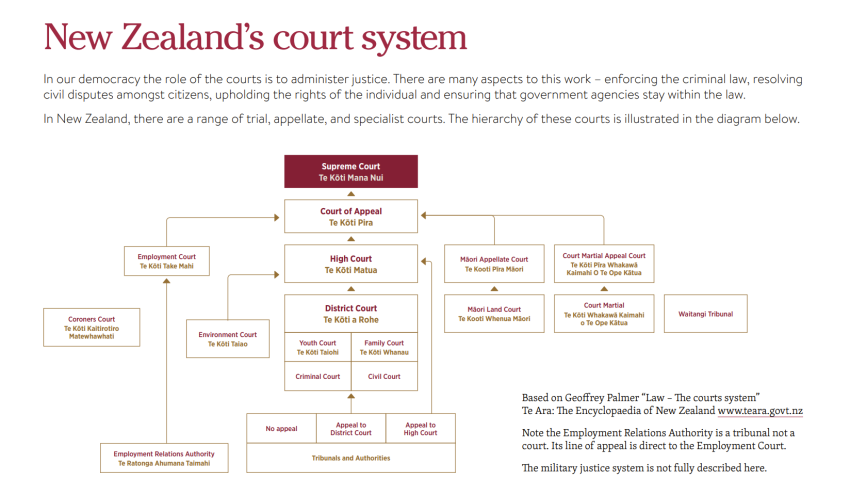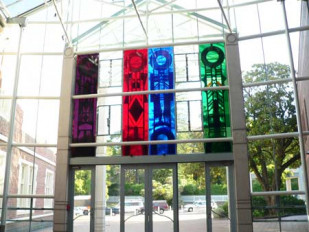History and role
Contents
Te Kōti Matua o Aotearoa
Supervisory role
Te Kōti Matua o Aotearoa
The High Court was established in December 1841 and was known as the Supreme Court until 1980. Its establishment followed the arrival in New Zealand of the first Chief Justice, William Martin, and the court heard its first case in January 1842.
The Court had the functions of the English common law and equity superior courts, and had jurisdiction in criminal trials, testamentary disputes, questions of lunacy, and admiralty matters. The Court also exercised general supervision over lower courts and tribunals and was the court of appeal for the magistrates’ courts.
The Court comprised the Chief Justice and several "puisne" judges. The number of judges increased according to the workload. The qualification for appointment was seven years' practice as a barrister or advocate of the United Kingdom, or as a barrister or solicitor of the Supreme Court of New Zealand.
British influence on the Court was strong throughout the 19th century. By the early 20th century, the courts were being redefined to better suit the needs of New Zealand. The Judicature Act 1908 defined the Supreme Court’s role, no longer by reference to British courts. Instead, it would have "all judicial jurisdiction which may be necessary to administer the laws of New Zealand".
During the early 1970s, there was a rise in the number of criminal jury trials and a substantial increase in the administrative law cases coming to the Court both in its appellate and supervisory jurisdiction. The High Court appellate jurisdiction rose too because of the greater jurisdiction of the district courts. As the workload rose, so too did the number of judges.
In 1980, the Supreme Court was renamed the High Court to free the name 'Supreme Court' for a final appellate court. The magistrates’ courts were renamed as district courts and were given some of the jurisdiction that had been exercised by the Supreme Court (High Court).
More than a century and a half since the first Chief Justice of New Zealand was appointed, the High Court remains the superior court of general jurisdiction in New Zealand. It has principal responsibility for maintaining the law through its supervisory and administrative law jurisdiction. It hears the more serious criminal and civil cases and exercises significant supervisory and appellate jurisdiction over lower courts and tribunals.
The Senior Courts Act 2016 replaced the Judicature Act 1908. No change was made to the High Court’s jurisdiction by the Senior Courts Act 2016.
Supervisory role
Jurisdiction
The judges
Administration
Decisions of the High Court are binding on all lower courts unless overruled by the Court of Appeal or Supreme Court. Because of its position in the judicial structure, the High Court is the court to which application is made for authoritative declarations of law.
The Court of Appeal is the third tier of this overall structure. It supervises, through appeal, the judgments of the High Court and ensures consistency in how the High Court applies the law.
To the existing general supervisory and appeal jurisdiction of the High Court, there are four exceptions:
- appeals from jury trials in the District Court go directly to the Court of Appeal;
- appeals from the Employment Court on questions of law are taken directly to the Court of Appeal;
- appeals from the Courts Martial Appeals Court go directly to the Court of Appeal; and
- appeals from the Māori Appellate Court go directly to the Court of Appeal.
While there is a wide range of statutes providing for appeals to the High Court from the lower courts and tribunals, the High Court secures, through judicial review, the legality of all public sector conduct, including that of the lower courts.
Structure of the courts
See the following diagram for an illustration of the hierarchy of New Zealand's court system. A PDF of this diagram is also available here: New Zealand's court system(PDF, 120 KB)

The obligation to supervise by judicial review is exercised both under common law inherent powers and under the Judicial Review Procedure Act 2016 . The power to supervise is central to the maintenance of law through judicial process. The High Court has no power, however, to supervise Parliament. The High Court cannot invalidate Acts of Parliament.
Jurisdiction
The jurisdiction of the High Court is largely conferred or arranged into a system by statutes. In addition, however, the High Court has inherent common law jurisdiction. No other court within the New Zealand legal system has a non-statutory substantive jurisdiction. The existence of such inherent jurisdiction means there is never a vacuum in obtaining vindication of right according to law.
The Court has all the jurisdiction which it had on the introduction of the Senior Courts Act 2016 and its predecessor, the Judicature Act 1908. It has all judicial jurisdiction which may be necessary to administer the laws of New Zealand. The Court therefore has both the statutory jurisdiction and inherent jurisdiction which are necessary for it to undertake its supervisory function.
The judges
After the Supreme Court was established as the final appeal court in New Zealand, the position of Chief High Court Judge was established. The role is ‘'responsible to the Chief Justice for ensuring the orderly and efficient conduct of the High Court's business''.
Associate judges have a specialist civil jurisdiction and undertake a range of companies and insolvency work. They have extensive jurisdiction in interlocutory matters including summary judgment applications, and they have jurisdiction to assess damages. Associate judges were formerly known as masters of the High Court and appointed for fixed terms. From 20 May 2004, masters were renamed associate judges and secured permanent tenure.
Acting judges of the High Court can be appointed by the Governor-General on the advice of the Attorney-General. An acting judge must hold or have held judicial office either as a High Court judge, an associate judge, or a District Court judge.
The eligibility rules for appointment as an acting associate judge are different. The appointee must be eligible for appointment as a judge under s 94 of the Senior Courts Act 2016 and be under 75 years of age or be either a current District Court judge or one who has retired or resigned.
The High Court uses acting judges very sparingly, where there is a temporary shortfall in the judicial workforce.
Administration
The High Court is a single national court which sits in several courthouses in different parts of the country. Judges are permanently located in Wellington, Auckland and Christchurch. High Court judges from the three main centres travel on circuit to other locations as needed. The work of the Court is organised nationally by the Chief High Court Judge to ensure a match between judicial resources and work.
Bibliography
- Spiller, Finn & Boast A New Zealand Legal History (2nd Edn) (2001)
- Report of the Royal Commission on the Courts , 1978
- The Laws of New Zealand, Reissue 1 (2004).

